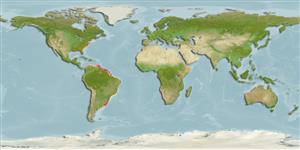Classification / Names
Nombres comunes | Sinónimos | Catalog of Fishes(Género, Especie) | ITIS | CoL | WoRMS | Cloffa
>
Scombriformes (Mackerels) >
Stromateidae (Butterfishes)
Etymology: Peprilus: Greek, peprilos, paprax, certain fish from Tracia.
Environment: milieu / climate zone / depth range / distribution range
Ecología
marino; salobre; rango de profundidad 13 - 136 m (Ref. 116249). Tropical
Distribución
Países | Áreas FAO | Ecosistemas | Ocurrencias, apariciones | Point map | Introducciones | Faunafri
Western Atlantic: French Guiana and Argentina
Tamaño / Peso / Age
Maturity: Lm ? range ? - ? cm
Max length : 22.0 cm TL macho / no sexado; (Ref. 124480); peso máximo publicado: 66.80 g (Ref. 118626)
Short description
Morfología | Morfometría
Espinas dorsales (total): 3 - 5; Radios blandos dorsales (total): 39-45; Espinas anales 3-4; Radios blandos anales: 36 - 41; Vértebra: 28 - 29. This species is distinguished from its congeners (except P. xanthurus) by having the following characters: precaudal vertebrae 11?12 (vs. 13 or more, rarely 12); total vertebrae 28?29 (vs. 30 or more in P. medius, P. ovatus, P. simillimus and P. snyderi); body height 58.5?79.0% SL (vs. 33.0?52.% SL in P. burti, P. simillimus, P. snyderi, P. ovatus and P. triacanthus); without series of pores along the front half of body under the dorsal fin (vs. 17?25 in P. triacanthus); a moderately falcate dorsal fin (vs. not falcate in P. triacanthus, or conspicuously falcate in P. paru); specimens larger than 9.0 cm SL, has an extremely falcate anal fin (vs. not falcate or moderately falcate in P. burti, P. simillimus, P. snyderi, P. ovatus and P. triacanthus); further distinguished from sympatric P. xanthurus by the lack of a conspicuous dark spot over the eyes, from snout to nape (vs. a conspicuous dark spot over the eyes, especially distinct in fresh specimens); in specimens smaller than 11.0 cm SL, orbital diameter is 1.6?5.0 in anal-fin height (vs. 5.1?8.0); in specimens larger than 10.9 cm SL, orbital diameter is 3.2?5.2 in anal-fin height (vs. 5.5?9.2), 2.9?3.8 in pectoral-fin height (vs. 3.9?5.9), and 0.8?1.4 in post-orbital length (vs. 1.5?2.3); further distinguished from P. paru by having a moderately long to short dorsal fin and relatively long caudal fin lobe, with length of lower lobe more than 1.2 times the length of the dorsal fin (vs. 1.2 times the length or less) (Ref. 116249).
Occurs in estuarine and coastal marine waters at depths of up to 136 meters. Probably does not form large schools for though it is common in the catches of artisanal fisheries (notably in Brazil), it is always in small numbers (Ref. 116249).
Life cycle and mating behavior
Madurez | Reproducción | Puesta | Huevos | Fecundidad | Larva
Marceniuk, A.P., R. Caires and R. Siccha-Ramirez, 2016. Review of the harvestfishes, genus Peprilus (Perciformes: Stromateidae), of the Atlantic coast of South America. Zootaxa 4098(2):311-332. (Ref. 116249)
IUCN Red List Status (Ref. 130435)
Threat to humans
Harmless
Human uses
Más información
PaísesÁreas FAOEcosistemasOcurrencias, aparicionesIntroduccionesStocksEcologíaDietacomponentes alimenticiosconsumo de alimentoRación
Nombres comunesSinónimosMetabolismoDespredadoresEcotoxicologíaReproducciónMadurezPuestaAgregación para la puestaFecundidadHuevosEgg development
ReferenciasAcuiculturaPerfil de acuiculturaRazasGenéticaElectrophoresesheritabilidadEnfermedadesProcesamientoNutrientsMass conversion
ColaboradoresImágenesStamps, Coins Misc.SonidosCiguateraVelocidadTipo de nataciónSuperficie branquialOtolitosCerebrosVisión
Herramientas
Special reports
Download XML
Fuentes de Internet
Estimates based on models
Phylogenetic diversity index (Ref.
82804): PD
50 = 0.5020 [Uniqueness, from 0.5 = low to 2.0 = high].
Bayesian length-weight: a=0.01622 (0.00965 - 0.02725), b=2.93 (2.79 - 3.07), in cm total length, based on LWR estimates for this species & Genus-body shape (Ref.
93245).
Nivel trófico (Ref.
69278): 3.9 ±0.2 se; based on size and trophs of closest relatives
Resiliencia (Ref.
120179): Alto, población duplicada en un tiempo mínimo inferior a 15 meses (Preliminary K or Fecundity.).
Fishing Vulnerability (Ref.
59153): Low vulnerability (12 of 100).
